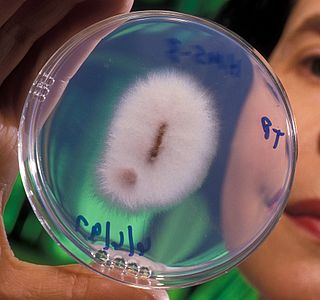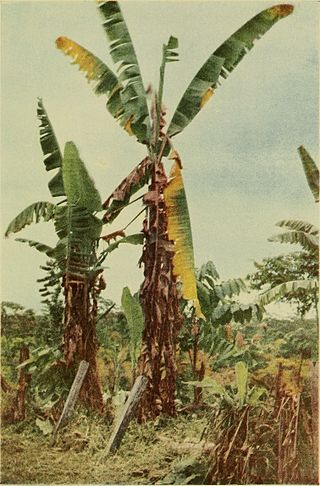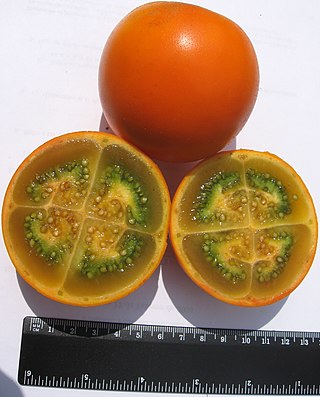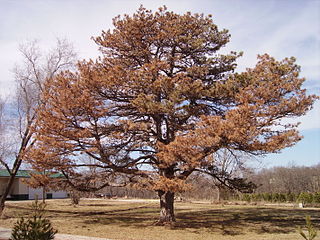
Fusarium oxysporum, an ascomycete fungus, comprises all the species, varieties and forms recognized by Wollenweber and Reinking within an infrageneric grouping called section Elegans. It is part of the family Nectriaceae.

Fusarium wilt is a common vascular wilt fungal disease, exhibiting symptoms similar to Verticillium wilt. This disease has been investigated extensively since the early years of this century. The pathogen that causes Fusarium wilt is Fusarium oxysporum. The species is further divided into formae speciales based on host plant.

Panama disease is a plant disease that infects banana plants. It is a wilting disease caused by the fungus Fusarium oxysporum f. sp. cubense (Foc). The pathogen is resistant to fungicides and its control is limited to phytosanitary measures.

Solanum quitoense, known as naranjilla in Ecuador, Costa Rica, and Panama and as lulo in Colombia, is a tropical perennial plant from northwestern South America. The specific name for this species of nightshade means "from Quito."

Verticillium wilt is a wilt disease affecting over 350 species of eudicot plants. It is caused by six species of Verticillium fungi: V. dahliae, V. albo-atrum, V. longisporum, V. nubilum, V. theobromae and V. tricorpus. Many economically important plants are susceptible including cotton, tomatoes, potatoes, oilseed rape, eggplants, peppers and ornamentals, as well as others in natural vegetation communities. Many eudicot species and cultivars are resistant to the disease and all monocots, gymnosperms and ferns are immune.

Nufar basil is the first variety of sweet basil that is resistant to fusarium wilt. Fusarium wilt is a disease that causes sudden wilting and death in multiple species, including basil. It is caused by the fungus Fusarium oxysporum f. sp. basilicum, which attacks the xylem in the stem, blocking water uptake and leading to a characteristic sudden leaf wilt that does not respond to watering. Nufar basil is resistant to fusarium wilt, remaining asymptomatic even when infected. It was released in 1999 in Israel by the breeders of the Agricultural Research Organization, and commercialized by Genesis Seeds.
Ceratocystis paradoxa or Black Rot of Pineapple is a plant pathogen that is a fungus, part of the phylum Ascomycota. It is characterized as the teleomorph or sexual reproduction stage of infection. This stage contains ascocarps, or sacs/fruiting bodies, which contain the sexually produced inoculating ascospores. These are the structures which are used primarily to survive long periods of time or overwinter to prepare for the next growing season of its host. Unfortunately, the sexual stage is not often seen in the natural field but instead the anamorph, or asexual stage is more commonly seen. This asexual stage name is Thielaviopsis paradoxa and is the common cause of Black rot or stem-end rot of its hosts.
Fusarium oxysporum f.sp. betae is a destructive fungal plant pathogen. It causes Fusarium yellows or fusarium wilt, characterized by yellowing and dwarfing.
Fusarium oxysporum f.sp. carthami is a fungal plant pathogen.

Fusarium oxysporum f.sp. ciceris is a fungal plant pathogen that causes fusarium wilt of chickpea.
Fusarium redolens is a species of fungus in the genus Fusarium and family Nectriaceae. This species is a soil-borne plant pathogen in temperate prairies. It causes diseases such as root, crown, and spear rot, seedling damping-off, and wilting disease. It is a known producer of the alkaloids peimisine and imperialine-3β-d-glucoside, which has implications for traditional Chinese medicine.
Phialophora gregata is a Deuteromycete fungus that is a plant pathogen which causes the disease commonly known as brown stem rot of soybean. P. gregata does not produce survival structures, but has the ability to overwinter as mycelium in decaying soybean residue.

A wilt disease is any number of diseases that affect the vascular system of plants. Attacks by fungi, bacteria, and nematodes can cause rapid killing of plants, large tree branches or even entire trees.

Solanum pseudolulo is a subtropical perennial plant from northwestern South America. The pseudolulo is a large herbaceous plant or a small shrub, with heart-shaped leaves. The leaves and stems of the plant are covered in short hairs, and the entire plant is often covered in sharp spines.
Black rot, caused by the bacterium Xanthomonas campestris pv. campestris (Xcc), is considered the most important and most destructive disease of crucifers, infecting all cultivated varieties of brassicas worldwide. This disease was first described by botanist and entomologist Harrison Garman in Lexington, Kentucky, US in 1889. Since then, it has been found in nearly every country in which vegetable brassicas are commercially cultivated.

Fusarium oxysporum f. sp. cubense is a fungal plant pathogen that causes Panama disease of banana, also known as Fusarium wilt. The fungi and the related disease are responsible for widespread pressure on banana growing regions, destroying the economic viability of several commercially important banana varieties.

Solanum caripense is a species of evergreen shrub native to South America and grown for its edible fruit.
Bayoud disease is an epiphytic fungal disease of date palm. The pathogen responsible for the disease is Fusarium oxysporum f.sp. albedinis.
Koa wilt is a relatively new disease to Hawaii, discovered in 1980. Koa wilt is caused by a forma specialis of the fungus Fusarium oxysporum, which is now abundant in Hawaiian soils and infects the native Acacia koa tree, a once-dominant species in the canopy of Hawaiian forests. Fusarium oxysporum f.sp. koae is believed to have been brought into Hawaii on an ornamental acacia plant. Fusarium fungi clog the tree xylem, causing significant wilt and mortality among Koa trees. Due to their cultural importance, Koa wilt is one of the Envirormental issues of Hawaii.
Coffee wilt disease (tracheomycosis) is a common wilt that results in complete death of coffee trees it infects. This vascular disease is induced by the fungal pathogen known by its teleomorph Gibberella xylarioides. In 1927, coffee wilt disease (CWD) was first observed in the Central African Republic where it developed slowly and went on to cause two epidemics between the 1930s and the 1960s. Coffee wilt disease was first seen in Coffea excelsa.









